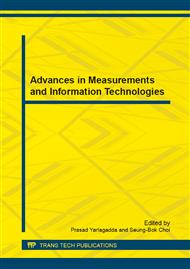[1]
Donnet, Benoit, and Timur Friedman. Internet topology discovery: a survey., Communications Surveys & Tutorials, IEEE 9. 4 (2007): 56-69.
DOI: 10.1109/comst.2007.4444750
Google Scholar
[2]
Stallings, William. SNMP, SNMPv2, SNMPv3, and RMON 1 and 2. Addison-Wesley Longman Publishing Co., Inc., (1998).
Google Scholar
[3]
Breitbart, Yuri, et al. Topology discovery in heterogeneous IP networks., INFOCOM 2000. Nineteenth Annual Joint Conference of the IEEE Computer and Communications Societies. Proceedings. IEEE. Vol. 1. IEEE, (2000).
DOI: 10.1109/infcom.2000.832196
Google Scholar
[4]
Lowekamp, Bruce, David O'Hallaron, and Thomas Gross. Topology discovery for large ethernet networks., ACM SIGCOMM Computer Communication Review. Vol. 31. No. 4. ACM, (2001).
DOI: 10.1145/964723.383078
Google Scholar
[5]
Bejerano, Yigal, et al. Physical topology discovery for large multisubnet networks., INFOCOM 2003. Twenty-Second Annual Joint Conference of the IEEE Computer and Communications. IEEE Societies. Vol. 1. IEEE, (2003).
DOI: 10.1109/infcom.2003.1208686
Google Scholar
[6]
Keromytis, Angelos D., Vishal Misra, and Daniel Rubenstein. Using overlays to improve network security., ITCom 2002: The Convergence of Information Technologies and Communications. International Society for Optics and Photonics, (2002).
Google Scholar
[7]
Ferguson, Paul. Network ingress filtering: Defeating denial of service attacks which employ IP source address spoofing., (2000). Information on http: /www. ietf. org/rfc/rfc2267. txt.
DOI: 10.17487/rfc2827
Google Scholar
[8]
Park, Kihong, and Heejo Lee. On the effectiveness of route-based packet filtering for distributed DoS attack prevention in power-law internets., ACM SIGCOMM Computer Communication Review. Vol. 31. No. 4. ACM, (2001).
DOI: 10.1145/964723.383061
Google Scholar
[9]
Peng, Tao, Christopher Leckie, and Kotagiri Ramamohanarao. Protection from distributed denial of service attacks using history-based IP filtering. " Communications, 2003. ICC, 03. IEEE International Conference on. Vol. 1. IEEE, (2003).
DOI: 10.1109/icc.2003.1204223
Google Scholar
[10]
Zhang, Guangsen, and Manish Parashar. Cooperative detection and protection against network attacks using decentralized information sharing., Cluster Computing 13. 1 (2010): 67-86.
DOI: 10.1007/s10586-009-0116-9
Google Scholar
[11]
DShield. org: Distributed intrusion detection system. November 2000. Information on http: /www. dshield. org.
Google Scholar


